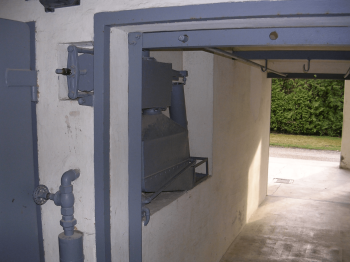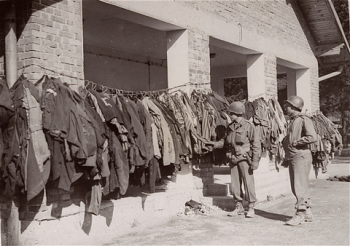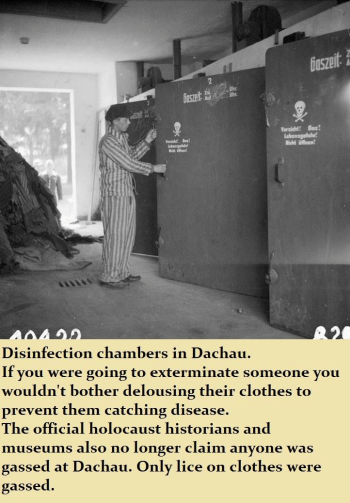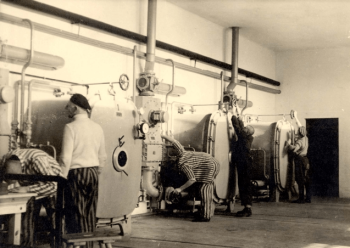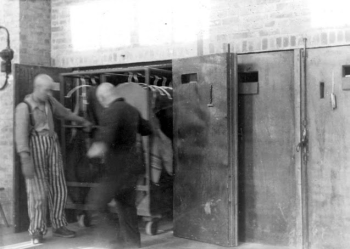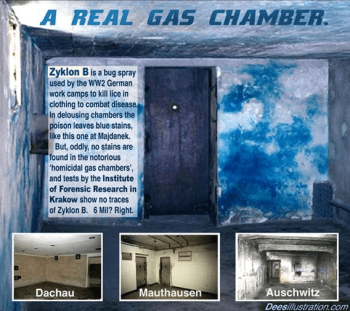The Holocaust: Difference between revisions
(Changed redirect target from The Holohoax to The holohoax) Tag: Redirect target changed |
m (i will add more info later) Tag: Removed redirect |
||
| Line 1: | Line 1: | ||
# | ===The Delousing Chambers: Hygiene Technology and Procedure at the Camps=== | ||
[[File:Dachau-Delousing-Chambers.png|thumb|350px|Dachau’s four fumigation chambers]] | |||
There were “real gas chambers” at all the camps. These chambers were not built, or used, to kill people, but were actually small, airtight chambers, usually no larger than big cupboards, in which prisoner clothes were deloused with Zyklon-B. Zyklon-B was used at the labour camps, not as a method of extermination but for the sake of maintaining hygiene among the inmates. It had been normal German technology since the 1920s. Typhus and dysentery were omnipresent problems at the camps where Zyklon-B was used as a disinfestant. | |||
New arrivals would strip off their clothes and throw them into the Gaskammer, then have a shower and if lice was suspected they would have their hair shaved. After a couple of hours the clothes would come back, bug-free. This technology enjoyed two years of intensive use, from 1942, when the great typhus epidemics struck, until 1944, when DDT started to be used and largely replaced hydrogen cyanide for eliminating the body louse that bore the typhus pathogene. A typical gas chamber would have a floor-space of some five square metres. A disinfestation cycle could last from one to several hours, depending on whether it was just clothing to be deloused, or thick mattresses. The manufacturers were proud of their efficient and scientifically-designed functioning: ''“This design has the greatest significance on the mass application of hydrocyanic acid fumigation facilities for mass delousing since it is only with such an installation that dependable results can be achieved in unusually short periods.”'' | |||
The American army used Zyklon, once the typhus epidemics started to arrive around 1942. A 1921 report in the New York Times titled “New Delousing Plant” described how immigrants infected with typhus were treated on Hoffman’s Island, New York. Their clothing was gassed with cyanide gas using their equivalent of Zyklon, while the immigrants had their hair cut off and were put through showers; then their clothes were returned. It was the same process in the German camps. | |||
The concept people call “Holocaust-Denial” means an affirmation concerning the manner in which normal hygiene technology worked, namely the opposite of what was affirmed at Nuremberg in 1946 – by US/UK military “intelligence” – whereby merely producing a can of Zyklon was taken as evidence of mass human gassing. A remarkable act of amnesia was then accomplished over the hygiene technology which used this product – which later became defunct as DDT replaced it. The ethically damned “denier” is one who realizes that, in response to the arrival of typhus epidemics in the German labour camps in 1942, delousing technology was installed throughout all of the German labour camps, so that safe-to-use cyanide gassing technology killed bugs in all clothing and bedding put into them; and that it didn’t have any other use. No-one at Nuremberg discussed whether the Zyklon-B canisters were for delousing of mattresses or gassing Jews. | |||
Not only are the delousing chambers too small for the imagined Holocaust gas chamber story, but their delicate apparatus would easily have been smashed to bits by desperate, dying humans. So what do “they” really look like, you ask? That’s easy to answer: they have never existed, they are a nightmare-hallucination of the same status as the satanic witches’ sabbaths used to convict witches centuries earlier. But to describe the actual German gas chambers: | |||
# They were ten cubic metres in volume. | |||
# They were manufactured by the firm Degesch, while Zyklon was manufactured by I.G. Farben, designed for compatible use with each other. | |||
# They blew hot air onto the Zyklon granules to evaporate the hydrogen cyanide gas. | |||
# They had a fan to circulate the gas. | |||
# They afterwards vented out the cyanide gas and replaced it with fresh air. | |||
# They often had a washing line outside, so after “Zykloning” the clothes and mattresses for an hour or so, they were put out to air. | |||
# Their intact remains exist today at four German labour camps: Dachau, Majdanek, Birkenau and Auschwitz. | |||
Admit it – that is the first description of German gas chambers you have ever read! You can’t have humans tossed into them. The former Auschwitz commander Rudolf Höss came up with a different story, which all the world now believes in – a tribute to the efficacy of British torture techniques. | |||
[[File:degesh-fumigation-device.png|thumb|350px|A Degesh hot air fumigation device. At the top the can opener controlled from the outside. The Zyklon pellets slide through the pipe into a wiremesh basket at the bottom, through which warm air is conducted by the heater/fan unit (below the can opener).]] | |||
To quote from an expert from DEGESCH, the manufacturing company. The design operated at ten grams per cubic metre of hydrogen cyanide for the delousing, equivalent to around 8,000 parts per million. All steps, including opening the tin of Zyklon B, were done remotely from outside the sealed apparatus, so no gas masks were normally required. Preheated circulated air was blown over the granules, spread out in a layer a centimetre thick, after which most of the cyanide would have evaporated after half an hour. The air needed to be about ten degrees above the boiling point of hydrogen cyanide (25.7°C) for it to vaporize quickly (also to increase bug metabolism). Efficient fans circulated that cyanide gas around the chamber. After an hour or two this lethal gas mixture was force-vented up a pipe and into the atmosphere. Then the chamber was ventilated with fresh air for a quarter of an hour, after which it was safe to open. The clothing or bedding was hung up outdoors to aerate, then returned to the owners. | |||
Rudolf Höss issued an order on 12 August 1942 that, when a disinfestation chamber was opened to the air, members of the SS not wearing gas-masks must keep at least 45 feet away from it for at least five hours. So this is, as it were, the real Höss speaking, before torture – one who was proud of his camp. This shows us the process which really happened, safe and efficiently designed, as one would expect from the Germans – in contrast to the hallucinatory nightmare today imagined by the world. | |||
[[File:Dachau-camp-Zyklon-B-dispenser.png|thumb|350px|Note the rail with hooks on the ceiling for hanging clothes.]] | |||
[[File:DisinfectedClothes.png|thumb|350px|American soldiers with deloused clothing airing outside the disinfestations chambers, 1945. The disinfestations chambers and Zyklon-B continued to be used after the Allied liberation of the camp, something that the Holocaust storytellers always neglect to tell.]] | |||
[[File:disinfection-chambers-dachau.png|thumb|350px]] | |||
Let’s consult an engineer’s wartime view, reviewing how efficiently the German gas chambers worked: | |||
<blockquote>“For the entire war until now, at 226 different sites, a total of 552 chambers with hydrocyanic acid circulatory fumigation systems and an additional 100 or so chambers without such equipment, but using hydrocyanic acid nonetheless, are either completed or under construction almost exclusively for the purpose of delousing … Thanks to the many delousing facilities which are already in operation and to the other stringent preventive measures, it has been possible, fortunately, to reduce dramatically the number of cases of typhus and the mortality in stark contrast to the earlier years… The increasingly widespread, harmless application of hydrocyanic acid, in itself highly toxic, in delousing chambers equipped with DEGESCH circulatory systems is a good indication of the dependability of this method.” | |||
– Emil Wüstinger, “Vermehrter Einsatz von Blausäure-Entlausungskammern” (Increased Use of Hydrocyanic Acid Delousing Chambers), Gesundheitsingenieur, 67(7) (1944), pp. 179f.</blockquote> | |||
He seems proud of their safety record and gives no hint of a lethal use. | |||
All documentation relating to “gassing equipment” which has been found in camp records refers specifically to the delousing chambers, and it has been one of the most dishonest tricks played by the Holocaust storytellers to proffer these completely innocent documents as “proof” of homicide. Architectural plans for delousing chambers exist (but are never shown as the “chambers” are far too small to be have been used as “mass gassing facilities”). There are also invoices for airtight doors, gas masks, Zyklon-B, extractor fans, clothing racks, and other supplies essential to delousing procedures. Despite the clear and obvious link between these items and the delousing chambers, the Holocaust storytellers have deliberately presented such documentation as “evidence” of homicidal gas chambers. The Germans were aware that lice infestations meant the outbreak of the deadly disease typhus, and that if that disease took hold, it could easily kill their precious labour force. They therefore took great precautions to prevent the outbreak of typhus, which included regular disinfections of the camp barracks. | |||
Auschwitz had a complex and well developed delousing system, consisting of a sophisticated series of larger disinfestation rooms called “autoclaves,” which used steam to kill lice in clothing. The autoclaves were remarkably efficient, and were obviously the source of far-fetched allegations in some Holocaust storyteller books of “executions in steam chambers” which occasionally make the rounds. Dirty clothes were on a hanger rack and then rolled into one end of the double-door autoclave. Once the clothes had been disinfected, the rack was rolled out on the “clean side” of the autoclave, with the division being necessary to ensure that infested clothing did not come into contact with the clean clothes. The idea that the Nazis would go through so much trouble to keep Jewish prisoners’ clothes clean in Auschwitz is completely at odds with the claim that they were simultaneously trying to kill millions of Jews. | |||
Surviving bills of lading for Zyklon-B, which are available for public inspection at the National Archives in the United States, show very clearly that Zyklon-B was shipped to all camps, and not just to the alleged gas chamber camps. The bills of lading in the US National Archives run from February16 to May 31, 1944, and reveal that the cases of cyanide crystals (Zyklon) are numbered in sequence (Nos. 50,053 to 50,210); each shipment consisted of thirteen cases, totaling 195 kg; and identical shipments—six each—went to Auschwitz and Oranienburg concentration camps. Oranienburg is situated in Germany, and not even the wildest Holocaust exaggeration has ever claimed that there was a homicidal gas chamber at that camp. The existence of proof of shipping of Zyklon-B to be used as a delousing agent to Oranienburg, is conclusive evidence of the real purpose for which that chemical was actually used in the camps. | |||
There are sixteen European nations where the proclamation of the normal working of hygiene technology in the German camps is a crime – that Zyklon-B was used for what it said on the can, viz. delousing, the alleged human gas chambers having been either washrooms or morgues. | |||
====Steam Disinfection Stations for Prisoner Clothing as Part of the Anti-Typhus Measures==== | |||
Typhus, borne by lice, as a continual threat to life in all the camps. The most common source of infection was to be found in clothing, and hence all the camps had extensive delousing installations. These delousing installations all had chambers in which lice were killed either by steam or by an insecticide called Zyklon-B, manufactured by the Degesch company. It is from these delousing stations that the Holocaust storytellers have developed the stories of “gas chambers,” “execution by steam” and “execution by Zyklon-B. | |||
Below: A battery of three autoclaves, showing prisoners at work in the camp. The steam arrived through the light colored pipe above the autoclaves, and the dark pipe connected the pressure vessel to the hot water tanks. An electric motor enabled the steam to be rapidly evacuated at the end of the cycle (to the left of each autoclave). On the table a prisoner is filling in the operating report and there is a clock for timing the sterilization cycle. The two short rails in front of each autoclave are to receive the trolley carrying the effects to be disinfected. Note also the healthy condition of the camp inmates. | |||
[[File:auschwitz-autoclaves.png|thumb|350px|Auschwitz autoclaves]] | |||
Below: Prisoners at Auschwitz working in one of the larger clothing disinfestation chambers in the camp. They worked in much the same way as the autoclaves, with “dirty” and “clean” sides. The peepholes in the doors could be closed by raising the flap and blocking it with a catch. These were opened at the end of a disinfestation cycle to allow fresh air to enter as soon as the extractor fans were switched on. | |||
[[File:auschwitz-disinfection-chamber.png|thumb|350px|Two inmates take out the clothes from a disinfestation chamber at Auschwitz.]] | |||
Microwave disinfestation technology was installed in the Auschwitz camp during the summer of 1944 and proved to be very effective. Germar Rudolf describes this as “the world’s first technological predecessor to the microwave ovens in common use today.” It was far more efficient and only took three minutes per sack of clothing. | |||
[[File:microwave-delousing-facility-auschwitz.png|thumb|350px|Microwave delousing facilities at Auschwitz]] | |||
[[File:gaschmbr_dees.png|thumb|350px]] | |||
[[File:zyk_dees.png|thumb|350px]] | |||
Revision as of 03:03, 14 September 2023
The Delousing Chambers: Hygiene Technology and Procedure at the Camps
There were “real gas chambers” at all the camps. These chambers were not built, or used, to kill people, but were actually small, airtight chambers, usually no larger than big cupboards, in which prisoner clothes were deloused with Zyklon-B. Zyklon-B was used at the labour camps, not as a method of extermination but for the sake of maintaining hygiene among the inmates. It had been normal German technology since the 1920s. Typhus and dysentery were omnipresent problems at the camps where Zyklon-B was used as a disinfestant.
New arrivals would strip off their clothes and throw them into the Gaskammer, then have a shower and if lice was suspected they would have their hair shaved. After a couple of hours the clothes would come back, bug-free. This technology enjoyed two years of intensive use, from 1942, when the great typhus epidemics struck, until 1944, when DDT started to be used and largely replaced hydrogen cyanide for eliminating the body louse that bore the typhus pathogene. A typical gas chamber would have a floor-space of some five square metres. A disinfestation cycle could last from one to several hours, depending on whether it was just clothing to be deloused, or thick mattresses. The manufacturers were proud of their efficient and scientifically-designed functioning: “This design has the greatest significance on the mass application of hydrocyanic acid fumigation facilities for mass delousing since it is only with such an installation that dependable results can be achieved in unusually short periods.”
The American army used Zyklon, once the typhus epidemics started to arrive around 1942. A 1921 report in the New York Times titled “New Delousing Plant” described how immigrants infected with typhus were treated on Hoffman’s Island, New York. Their clothing was gassed with cyanide gas using their equivalent of Zyklon, while the immigrants had their hair cut off and were put through showers; then their clothes were returned. It was the same process in the German camps.
The concept people call “Holocaust-Denial” means an affirmation concerning the manner in which normal hygiene technology worked, namely the opposite of what was affirmed at Nuremberg in 1946 – by US/UK military “intelligence” – whereby merely producing a can of Zyklon was taken as evidence of mass human gassing. A remarkable act of amnesia was then accomplished over the hygiene technology which used this product – which later became defunct as DDT replaced it. The ethically damned “denier” is one who realizes that, in response to the arrival of typhus epidemics in the German labour camps in 1942, delousing technology was installed throughout all of the German labour camps, so that safe-to-use cyanide gassing technology killed bugs in all clothing and bedding put into them; and that it didn’t have any other use. No-one at Nuremberg discussed whether the Zyklon-B canisters were for delousing of mattresses or gassing Jews.
Not only are the delousing chambers too small for the imagined Holocaust gas chamber story, but their delicate apparatus would easily have been smashed to bits by desperate, dying humans. So what do “they” really look like, you ask? That’s easy to answer: they have never existed, they are a nightmare-hallucination of the same status as the satanic witches’ sabbaths used to convict witches centuries earlier. But to describe the actual German gas chambers:
- They were ten cubic metres in volume.
- They were manufactured by the firm Degesch, while Zyklon was manufactured by I.G. Farben, designed for compatible use with each other.
- They blew hot air onto the Zyklon granules to evaporate the hydrogen cyanide gas.
- They had a fan to circulate the gas.
- They afterwards vented out the cyanide gas and replaced it with fresh air.
- They often had a washing line outside, so after “Zykloning” the clothes and mattresses for an hour or so, they were put out to air.
- Their intact remains exist today at four German labour camps: Dachau, Majdanek, Birkenau and Auschwitz.
Admit it – that is the first description of German gas chambers you have ever read! You can’t have humans tossed into them. The former Auschwitz commander Rudolf Höss came up with a different story, which all the world now believes in – a tribute to the efficacy of British torture techniques.
To quote from an expert from DEGESCH, the manufacturing company. The design operated at ten grams per cubic metre of hydrogen cyanide for the delousing, equivalent to around 8,000 parts per million. All steps, including opening the tin of Zyklon B, were done remotely from outside the sealed apparatus, so no gas masks were normally required. Preheated circulated air was blown over the granules, spread out in a layer a centimetre thick, after which most of the cyanide would have evaporated after half an hour. The air needed to be about ten degrees above the boiling point of hydrogen cyanide (25.7°C) for it to vaporize quickly (also to increase bug metabolism). Efficient fans circulated that cyanide gas around the chamber. After an hour or two this lethal gas mixture was force-vented up a pipe and into the atmosphere. Then the chamber was ventilated with fresh air for a quarter of an hour, after which it was safe to open. The clothing or bedding was hung up outdoors to aerate, then returned to the owners.
Rudolf Höss issued an order on 12 August 1942 that, when a disinfestation chamber was opened to the air, members of the SS not wearing gas-masks must keep at least 45 feet away from it for at least five hours. So this is, as it were, the real Höss speaking, before torture – one who was proud of his camp. This shows us the process which really happened, safe and efficiently designed, as one would expect from the Germans – in contrast to the hallucinatory nightmare today imagined by the world.
Let’s consult an engineer’s wartime view, reviewing how efficiently the German gas chambers worked:
“For the entire war until now, at 226 different sites, a total of 552 chambers with hydrocyanic acid circulatory fumigation systems and an additional 100 or so chambers without such equipment, but using hydrocyanic acid nonetheless, are either completed or under construction almost exclusively for the purpose of delousing … Thanks to the many delousing facilities which are already in operation and to the other stringent preventive measures, it has been possible, fortunately, to reduce dramatically the number of cases of typhus and the mortality in stark contrast to the earlier years… The increasingly widespread, harmless application of hydrocyanic acid, in itself highly toxic, in delousing chambers equipped with DEGESCH circulatory systems is a good indication of the dependability of this method.” – Emil Wüstinger, “Vermehrter Einsatz von Blausäure-Entlausungskammern” (Increased Use of Hydrocyanic Acid Delousing Chambers), Gesundheitsingenieur, 67(7) (1944), pp. 179f.
He seems proud of their safety record and gives no hint of a lethal use.
All documentation relating to “gassing equipment” which has been found in camp records refers specifically to the delousing chambers, and it has been one of the most dishonest tricks played by the Holocaust storytellers to proffer these completely innocent documents as “proof” of homicide. Architectural plans for delousing chambers exist (but are never shown as the “chambers” are far too small to be have been used as “mass gassing facilities”). There are also invoices for airtight doors, gas masks, Zyklon-B, extractor fans, clothing racks, and other supplies essential to delousing procedures. Despite the clear and obvious link between these items and the delousing chambers, the Holocaust storytellers have deliberately presented such documentation as “evidence” of homicidal gas chambers. The Germans were aware that lice infestations meant the outbreak of the deadly disease typhus, and that if that disease took hold, it could easily kill their precious labour force. They therefore took great precautions to prevent the outbreak of typhus, which included regular disinfections of the camp barracks.
Auschwitz had a complex and well developed delousing system, consisting of a sophisticated series of larger disinfestation rooms called “autoclaves,” which used steam to kill lice in clothing. The autoclaves were remarkably efficient, and were obviously the source of far-fetched allegations in some Holocaust storyteller books of “executions in steam chambers” which occasionally make the rounds. Dirty clothes were on a hanger rack and then rolled into one end of the double-door autoclave. Once the clothes had been disinfected, the rack was rolled out on the “clean side” of the autoclave, with the division being necessary to ensure that infested clothing did not come into contact with the clean clothes. The idea that the Nazis would go through so much trouble to keep Jewish prisoners’ clothes clean in Auschwitz is completely at odds with the claim that they were simultaneously trying to kill millions of Jews.
Surviving bills of lading for Zyklon-B, which are available for public inspection at the National Archives in the United States, show very clearly that Zyklon-B was shipped to all camps, and not just to the alleged gas chamber camps. The bills of lading in the US National Archives run from February16 to May 31, 1944, and reveal that the cases of cyanide crystals (Zyklon) are numbered in sequence (Nos. 50,053 to 50,210); each shipment consisted of thirteen cases, totaling 195 kg; and identical shipments—six each—went to Auschwitz and Oranienburg concentration camps. Oranienburg is situated in Germany, and not even the wildest Holocaust exaggeration has ever claimed that there was a homicidal gas chamber at that camp. The existence of proof of shipping of Zyklon-B to be used as a delousing agent to Oranienburg, is conclusive evidence of the real purpose for which that chemical was actually used in the camps.
There are sixteen European nations where the proclamation of the normal working of hygiene technology in the German camps is a crime – that Zyklon-B was used for what it said on the can, viz. delousing, the alleged human gas chambers having been either washrooms or morgues.
Steam Disinfection Stations for Prisoner Clothing as Part of the Anti-Typhus Measures
Typhus, borne by lice, as a continual threat to life in all the camps. The most common source of infection was to be found in clothing, and hence all the camps had extensive delousing installations. These delousing installations all had chambers in which lice were killed either by steam or by an insecticide called Zyklon-B, manufactured by the Degesch company. It is from these delousing stations that the Holocaust storytellers have developed the stories of “gas chambers,” “execution by steam” and “execution by Zyklon-B.
Below: A battery of three autoclaves, showing prisoners at work in the camp. The steam arrived through the light colored pipe above the autoclaves, and the dark pipe connected the pressure vessel to the hot water tanks. An electric motor enabled the steam to be rapidly evacuated at the end of the cycle (to the left of each autoclave). On the table a prisoner is filling in the operating report and there is a clock for timing the sterilization cycle. The two short rails in front of each autoclave are to receive the trolley carrying the effects to be disinfected. Note also the healthy condition of the camp inmates.
Below: Prisoners at Auschwitz working in one of the larger clothing disinfestation chambers in the camp. They worked in much the same way as the autoclaves, with “dirty” and “clean” sides. The peepholes in the doors could be closed by raising the flap and blocking it with a catch. These were opened at the end of a disinfestation cycle to allow fresh air to enter as soon as the extractor fans were switched on.
Microwave disinfestation technology was installed in the Auschwitz camp during the summer of 1944 and proved to be very effective. Germar Rudolf describes this as “the world’s first technological predecessor to the microwave ovens in common use today.” It was far more efficient and only took three minutes per sack of clothing.


